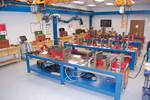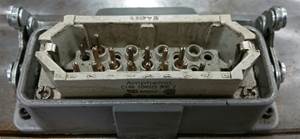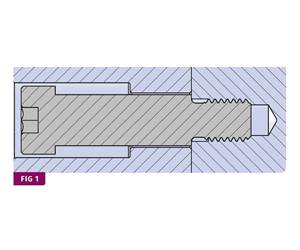Tooling: Setting Up Shop: Part III
Our last column covered shop size and bench requirements for a 50 x 50 ft mold-repair shop that will have a MPP (Mold Pull Pace) of approximately 25 to 30 multi-cavity molds a week and employ four repair technicians in a six-bench layout.
Our last column covered shop size and bench requirements for a 50 x 50 ft mold-repair shop that will have a MPP (Mold Pull Pace) of approximately 25 to 30 multi-cavity molds a week and employ four repair technicians in a six-bench layout. The next topic to consider is mold handling.
Just as important as workbench design—and by far, the one aspect of mold repair most taken for granted—is the overhead hoist system. Installing a hoist system can be the single highest expenditure in constructing a mold-repair area. And once the system is installed, you live with it forever. It’s not something that you can afford to change your mind about after a year or two, so give traffic flow considerable thought, keep expansion in mind, and don’t automatically assume a bridge crane is the best option.
A properly designed and smoothly operating hoist is a valuable tool that should not be limited to just moving molds about the toolroom, but should be utilized continually to allow the technician to position mold plates and tooling in a more comfortable arrangement. That translates into more accurate, efficient, and safer repairs.
For instance, a plate leaning back and facing you at a 30° angle while supported by the hoist is much more comfortable to work on and allows for better control of hand tools during repairs or visual inspection of bores and tooling than if the plate were standing upright. Many times you will lift a plate or mold to get specific areas at eye level for closer view while allowing you to stretch/straighten your hunchback. If the hoist is not available, mobility is limited.
To improve maintenance efficiency, technicians must have access to a hoist when they need it, which always seems to be when someone else is using it. Standing around waiting for the hoist to become available can ultimately cost thousands of dollars in extended repair hours and lost production.
Having worked under most types of cranes and hoists available today has allowed me to develop some opinions concerning pros and cons of different systems. Some hoist systems can turn a simple mold assembly into a gut-wrenching exercise in uncontrolled plate movement, while others are just plain dangerous to work with. If the main function of the crane is to service a mold-repair area, careful thought must be given to achieve a design that will provide the safest and most efficient workflow through all the stages of mold repair and cleaning. This includes how to handle the molds to get them in the shop, split, and on the bench.
Here are the pros and cons of the two most popular systems as they pertain to repairing molds in a busy four- to six-man shop:
THE BRIDGE CRANE
The Pros: Accessibility
- Molds can be moved from practically any point in the shop to any other point. You can go from the shop entrance to a bench, from bench to bench, to a cleaning area, and finally to a rack (storage) area without need for a forklift or moveable mold tables.
- If your business is total mold refurbishing, it’s easy to move heavy mold plates and tooling to a mill, grinder, or other machine tools right from the bench, as long they are located within the footprint of the hoist travel.
- If you like to periodically change the layout of a toolroom, it is easy to reposition machine tools.
The Cons: Communal Property
- There is normally only one hoist on a bridge crane for all to share. This is a potentially huge bottleneck in a busy shop, especially one cycling 30 molds or more through per week. To offset not having a hoist available, repair techs will attempt to manhandle or “forklift” plates or tooling that should be left for a hoist. This translates into blown-out backs and nicked-up or severely damaged tooling while a mold hangs on the hoist waiting for Bob to get back from lunch.
Shop Dis-organization
- The ability to set a mold and plates anywhere does not bode well for a shop whose employees do exactly that, clogging up walkways and impeding smooth, safe traffic flow.
Lack of Control
- Bridge cranes are not normally designed to be manipulated manually. All mold and plate positioning requires a handset that controls hoist motors for movement up, down, left, right, forward, and backward. Safe and accurate mold assembly or disassembly relies on the technician’s ability to minutely adjust plate position for absolute alignment of pins, bushings, and other tooling. Six-button crane handsets are large; sometimes requiring both hands to operate and forcing you to take your eyes off the plate you want to assemble. Attempting to one-hand it can cause you to hit the wrong button, thus binding or tipping a plate over. Some technicians will get a mold plate close to the starting position, then attempt to swing it onto the bushings to engage the pins, which usually ends up binding the plate, and then finally tap the correct button to move the hoist in the needed direction to slide things together. Tap the wrong button and it’s a train wreck.
Cost
- Since a bridge crane would span the entire length and half the width of our shop—or 50 x 25 ft, the cost could end up being 50% more than a monorail with four fixed beams sitting on block walls. At our training facility, a low ceiling dictated a bridge-crane system this size at a cost, including installation, of $30,000 (see photo).
THE MONORAIL
(Single I-beam fixed over each bench)
Pros: Positive Control
- Monorails are fixed directly over the center of a bench. This ensures that mold plates always hang centered and in line with each other during disassembly and assembly. The control box is much smaller and requires only one hand to actuate two buttons that control the up/down movement of the hoist. Left/right hoist travel is usually controlled manually unless the ceiling height is over 20 ft. This greatly improves physical control and allows the other hand and both eyes to focus on the movement of the plate.
Availability and Housekeeping
- No waiting for the hoist. Time is money. Every technician needs to be able to use the hoist during all stages of repair, whenever necessary. There also will be fewer accidents and arguments concerning whose turn it is and “why did you set that there?” Since molds cannot be placed randomly about the shop, aisles stay clear. Molds are stored where they belong, not where it is convenient.
Cost and Upkeep
- It is considerably less expensive to install a monorail system that will service only the workbench area, even with the added cost of a two-speed hoist over each bench, simply because there is less steel involved. Also, supporting the monorails in the center of the long run will allow the use of a smaller and less expensive I-beam than one that must span the entire work area.
- Since the only moving/working part of the system is the hoist, annual upkeep through inspections and long-term maintenance costs on this type system are also lower.
Cons: Limited Coverage
- Monorails only service the area directly over, and usually six to eight ft past, either end of the bench. This means molds must be brought to the bench via forklift.
- Plates and tooling must be off-loaded to a mobile table to be taken to the cleaning area. This could be a problem with large molds weighing more than 10,000 lb.
- Low ceilings (10 ft or less) can rule out this system for molds larger than 3000 lb.
Floor Post Supports
- To keep steel costs down, a typical 12- to 18-in. I-beam is usually floor supported if the wall-to-wall span is more than 40 ft. For our shop, this means dodging two floor posts.
OTHERS, NOT RECOMMENDED
- A-frames are dangerous to use. I have seen them tip while moving molds, and they are too awkward around a bench. They require the technician to position himself or herself in harm’s way to jockey a mold onto the bench and into a workable position.
- Jib cranes consist of a large column bolted to the floor with a lift arm that rotates around the column. They also are clumsy to use, simply because you have to control the rotation of the arm during linear travel while lining up plates. So unless you are prepared to have your benches placed like spokes in a wheel that a jib rotates around, I’d skip it.
Although I have seen it done many times, designing and installing a hoist system is not a job for the plant handyman. Determine your traffic flow, then get a crane/hoist systems expert to come in and examine your walls, floors, and overhead girders for structural issues that might cause load-bearing problems. And shop around. New technology (such as aluminum sections) for hoist systems under 3 tons can greatly simplify construction.
About the Author
Steven Johnson is the operations manager for ToolingDocs LLC, part of the PCIC Group of Companies. Steve also has is own business, MoldTrax in Ashland, Ohio. He can be reached at steve.johnson@toolingdocs.com or (419) 289-0281.
Related Content
Hot Runners: How to Maintain Heaters, Thermocouples, and Controls
I conclude this three-part examination of real-world problems and solutions involving hot runners by focusing on heaters, thermocouples, and controls. Part 3 of 3.
Read MoreWhy Shoulder Bolts Are Too Important to Ignore (Part 2)
Follow these tips and tricks for a better design.
Read MoreWhere and How to Vent Injection Molds: Part 3
Questioning several “rules of thumb” about venting injection molds.
Read MoreWhy Shoulder Bolts Are Too Important to Ignore (Part 1)
These humble but essential fasteners used in injection molds are known by various names and used for a number of purposes.
Read MoreRead Next
Tooling: Setting Up a Mold Shop: Part I
I had a toolmaker once tell me he used to slam his hand in his car door before work every morning just to get him in the right frame of mind to work in his shop.
Read MoreSee Recyclers Close the Loop on Trade Show Production Scrap at NPE2024
A collaboration between show organizer PLASTICS, recycler CPR and size reduction experts WEIMA and Conair recovered and recycled all production scrap at NPE2024.
Read More



















